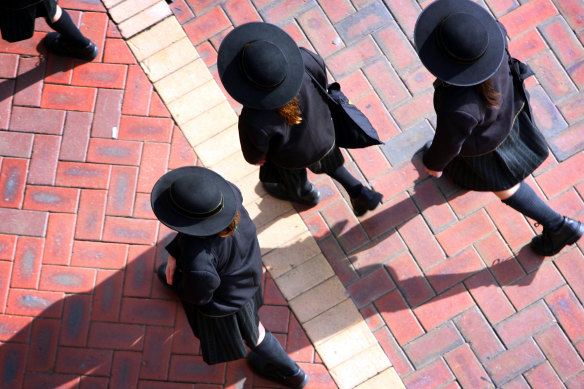By Lucy Carroll and Nigel Gladstone
Students in Sydney are up to four times as likely to take advanced maths and English courses for their HSC than those in regional areas, sparking concerns a growing number of students face limited access to the most rigorous, high-scaling courses.
Data obtained by the Herald reveals fewer than 50 students in some regions studied economics, physics or extension maths courses for last year’s HSC.
Principals say some schools across NSW lack sufficient student enrolments in sciences and maths courses to make it viable for schools to offer them.
“It’s a complex issue that’s linked to subject exposure and student aspiration. But looking at the pervasive achievement gap, which is getting worse, this is part of the reason behind that,” said Craig Petersen, head of the NSW Secondary Principals Council.
“If a school doesn’t offer physics or drama one year – or a teacher leaves – then principals can find it extremely hard to ever get these subjects up and running again,” he said.
The RBA’s head of information department, Jacqui Dwyer, said last week that the dramatic fall in high school students taking economics in the past few decades was stark in regional and public schools.
Figures for all school sectors show about 2 per cent of HSC students in the mid-north coast, Grafton and Newcastle studied economics last year, compared with more than 10 per cent in Parramatta and Baulkham Hills. Some regions had fewer than 20 students taking the subject.
“Exclusivity is becoming a hallmark of economics, and yet [the discipline] … can shape the future of economic thought and practice, and improve the quality of public discourse and public policy,” Dwyer said. “We can also see the displacement of economics by business studies.”
Dwyer said 30 per cent of NSW public schools now offer economics, compared with almost every school in the early 1990s. The proportion of year 12 students taking economics from regional schools has halved in that time, she said.
“It is now a rarity for economics to be offered at schools outside the major cities,” she said.
For advanced English, most regional areas had less than 25 per cent of HSC students taking the course, compared with almost 55 per cent in east and north Sydney.
Almost 37 per cent of students did advanced maths in some parts of Sydney, while 8 per cent took the subject in the far west. For the maths extension 1 course, about 3 per cent took the subject in some regional areas, compared with 24 per cent in the eastern suburbs.
Just 42 took extension 1 maths on the Mid North Coast, compared with 1550 in North Sydney.
University of Canberra associate professor Philip Roberts said teacher shortages are exacerbating the differences in enrolments, particularly in maths and science.

Fewer than 50 students in some regions of NSW studied economics, physics or extension maths courses for last year’s HSC.Credit: iStock
“Staffing formulas also mean smaller schools simply do not have the teachers to ensure subject breadth,” said Roberts, a rural education researcher who has previously warned limited curriculum options are causing poorer students to lower their aspirations.
“This has huge implications for achieving the University Accord objectives. Getting more students into university is unattainable unless more students study these powerful subjects, or we change university entry systems. At present, these students are essentially locked out.”
Roberts’ research has found the most advantaged students have better access to high-status subjects including chemistry and Latin.
“Some struggle to see themselves in these subjects, or how they link to future careers. Historically, the HSC subjects students take relate to their socio-economic background, and in an increasingly segregated school system, the school students attend.”

About 2 per cent of students in the state’s far west studied HSC economics last year, compared with 13 per cent in North Sydney.Credit: Louie Douvis
Roberts says encouraging more students into calculus-based maths courses needs to begin in early high school. “More focus also needs to go into careers education, which is very poor in some areas and many schools don’t have careers advisers full-time,” he said.
A spokesperson for the NSW Education Department said regardless of where students live, those undertaking their HSC may also be eligible to study certain subjects, such as advanced English, via a range of initiatives including distance education and virtual school Aurora College.
Petersen said when he taught at a Riverina high school in the late 1990s he took a 3-unit English class of nine students. Last year, 33 students took the equivalent subject (English extension1) in the entire region.
“The decline in some regional populations, which then feeds into the decline in enrolments, has an impact on the viability of classes,” he said.
“Teacher availability plays into this and community expectations. But the biggest thing is having a critical mass of students, so a school can offer a subject. In some regional schools about 30 per cent of students are actively pursuing an ATAR,” said Petersen.
Deputy president at Secondary Principals Council Charles Gauci said many students at regional schools are opting for more practical Vocational Education and Training (VET) courses. “Students are looking at which career path they want to take and are choosing the subjects that are relevant and have a genuine interest in,” he said.
“Many small schools will make allowances if a student wants to take a certain subject, and they find ways to offer it. Distance education can be so valuable,” he said.
The size of the HSC cohorts used in the analysis range from about 750 in smaller regions to up to 6500 in the city.
Margery Evans, head of the Association of Independent Schools of NSW, said many schools in Sydney’s north and east with larger proportions taking higher-level maths and English are selective public or independent schools which draw students from across the city and western and southern suburbs.
“Teacher surveys have highlighted the lack of specialist teachers for higher level maths and science subjects. Schools try to compensate for this by using strategies such as distance education,” she said.
Catholic Schools NSW chief executive Dallas McInerney said almost all Catholic schools across the state had candidates taking advanced English last year.
“We want to push through any postcode barriers to opportunities. Access to experienced teachers, role models, extra support including tutors and subject selection processes play major roles in subjects students take,” McInerney said.
A NESA spokesperson said students are encouraged to choose HSC subjects they are interested in and that align to their post-school goals.
“As part of the NSW Curriculum Reform teachers are being supported to deliver new evidence-based syllabuses, which explicitly outline the knowledge and skills students need to learn – building on foundational knowledge at each stage,” they said.
Start the day with a summary of the day’s most important and interesting stories, analysis and insights. Sign up for our Morning Edition newsletter.